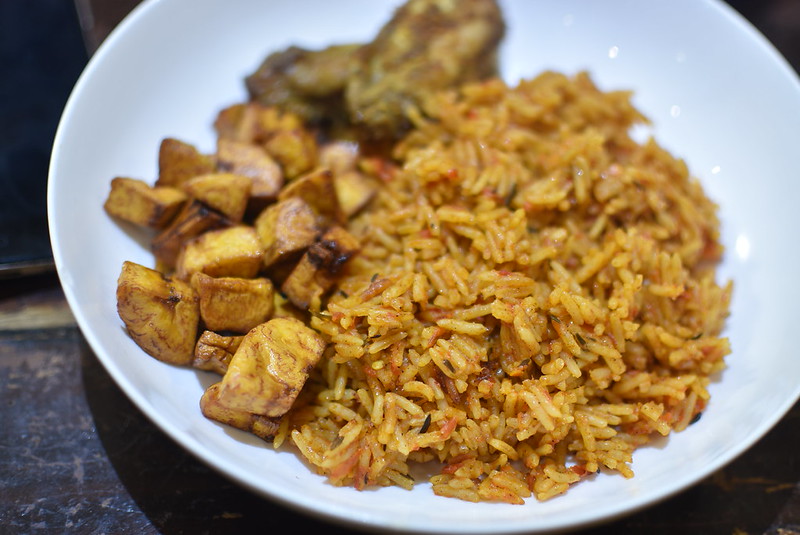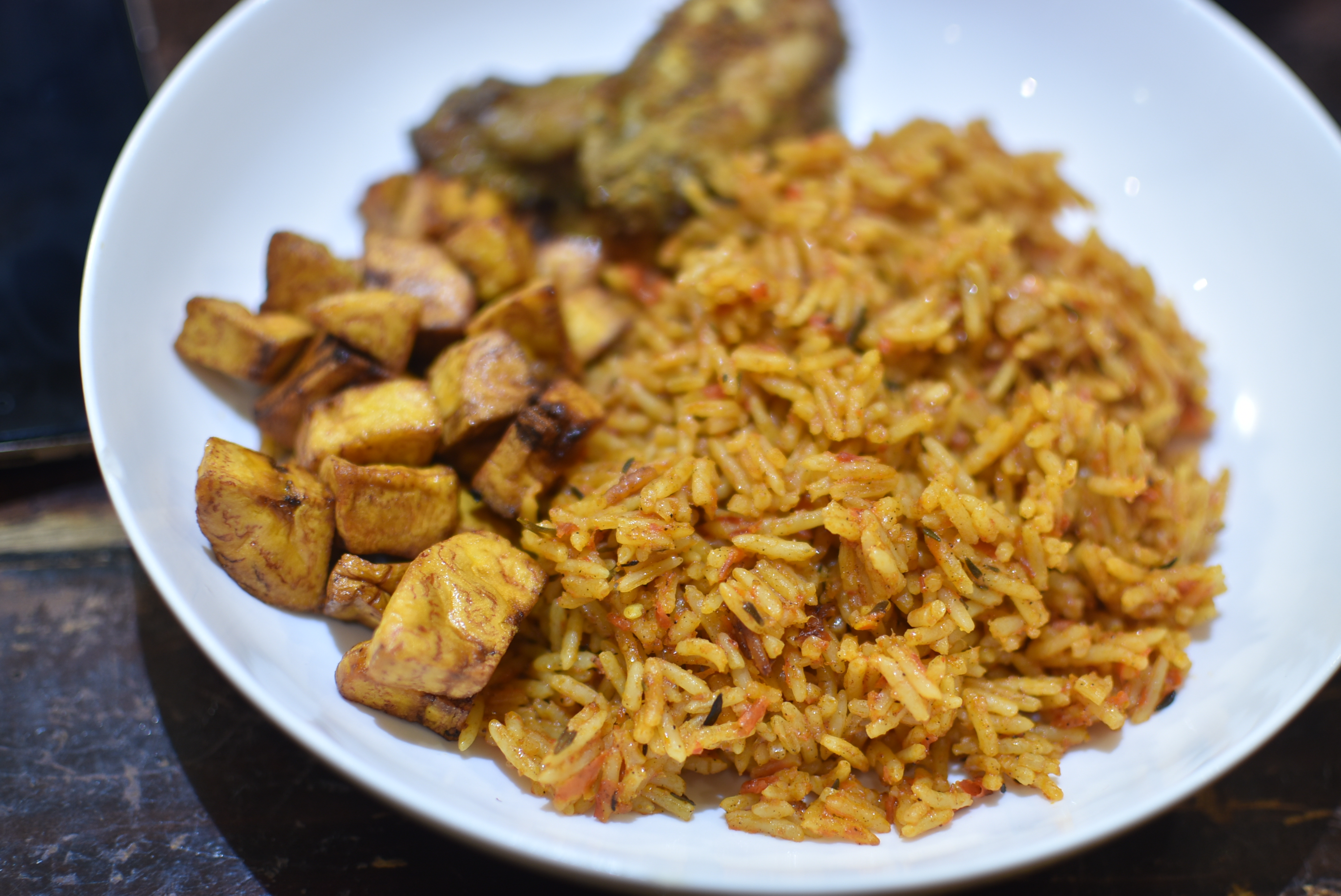I’m a dab hand at Jollof – she laughs in red and spice. Well, I’ve finally gotten things down to at least consistent, delicious results. That’s with long grain rice though, not basmati.
Learning to make basmati Jollof has been a lifelong dream, from the days of Holland when @olayide_williams and I would order stunning basmati Jollof from Bose, 80 euros for a huge tub that we’d work our way through in days
However, my basmati game was so weak – the rice always ended up mushy or broken, I never got the right kind of taste….till last week when a friend, A came over. A is T’s mum. T is friends with R, daughter #2 – picky eater extraordinaire. So one day, we’re at T’s house, R refuses to leave because #Jrice is cooking. When it’s done, she gets a huge bowl and I taste a bit. Mind blown. Mind blown. Mind actually blown. My friends actually have the rice game on lockdown, from fried to J!
I started pestering A to teach me. And I learnt last night. She brought all the ingredients, I brought the meat stock and history was made. When we began, A told me a few things
- how she uses the same number of tomatoes and tatashe (red poblanos) and how that generally translates into a 60:40 ratio by weight
- how the weight of the tomatoes and rice were the same though she’d never measured by weight, just eyeballed. When we measured though, she was so close to the truth, we both shivered. With excitement. There’s a lot of science and ratios to perfect dishes – perfect being your own spec, apart from when it comes to dodo but that’s for another day.
- Also, she only cooks her basmati Jollof in a non-stick pot
Here’s what I learnt about cooking basmati Jollof:
1. The right rice will give the right Jollof rice!
Use #goldensella. It’s a parboiled basmati – yellowish, long grain and steamed during the processing. It’s similar to our/ Thai long grain varieties only slimmer. The science behind parboiling opens up the grain, makes the nutrients more bio available and allows flavors in. Generally speaking, parboiled rice is more nutritious than white rice.
The milling procedure of Golden Sella Rice differentiates itself from any other form of rice. It is ensured that the paddy is first steamed and further dried, for the purpose of milling. Later the rice is gently parboiled to lock-in the nutrients. This help in lending the grains form a long slender shape and adapt a soft golden or a yellow colour.
This rice has a strong ability to absorb the flavours of herbs, spices and much more, and that is why it is used in variety of Persian cuisines such as Pulao, Biryani etc. A dish can look appealing if golden Sella rice is used. Since, the grains are elongated post-cooking and further adds aroma, flavour, fragrance as well as visual beauty to the dish. Also, each rice grain separates out perfectly after cooking. Golden Sella Rice is also appreciated for various health benefits; Source – Quora
Golden sella rice is the cultivar – different brands have their golden sella. It is also called 1121 Golden sella – one of over 40 varieties. A swears by Asli, pictured below.
2. We used raw rice, just washed – not parcooked
3. Tomato paste isn’t a necessity. My friend used a lot of fresh tomatoes and tatashe (#redpoblano) and no tomato paste
4. We didn’t use any salt – we only used seasoning cubes
5. Our seasoning consisted of curry powder, dried thyme, stock cubes, black and white pepper. No salt. Because when you use stock cubes, you shouldn’t use salt
6. Once the rice is in, cook on the lowest temperature possible so the rice steams. You stir a couple of times till its ready
The results were stunning and I’ve since made a couple of pots with great results – still learning though! I am super pleased that finally, I’ve crossed that bridge and I can cook basmati Jollof. My life will never be the same again! Thank you! What do you think? What tips and tricks do you have in cooking with golden sella?
- 1/4 cup vegetable oil
- 3 red onions - 2 1/2 roughly chopped; 1/2 sliced
- 800g fresh tomatoes, roughly chopped
- 600g tatashe (red poblano, bell peppers), seeds removed & roughly chopped
- 1 - 2 habanero, to taste
- 4 - 5 cups of stock
- Curry powder, to taste
- Dried thyme, to taste
- Ground white pepper, to taste
- Ground black pepper, to taste
- Stock cubes or salt
- 800g golden sella basmati rice, washed till water runs clear
- Blend the fresh tomatoes, tatashe, roughly chopped onions and habanero. Blend till smooth - you may have to do this in batches depending on the size of your blender
- Heat up a large non-stick pot and add the oil. Once it's heated, add the sliced onions and stir till golden brown
- Add the blended tomato mixture (~7 cups) and 3 cups of stock
- Season with 1 teaspoon each of curry powder and dried thyme; 1/2 a teaspoon each of ground white pepper and ground black pepper; and 2 - 3 seasoning cubes. If you're using seasoning cubes - don't use salt, and vice versa as seasoning cubes already come salted
- Put the lid on the pot and let cook on medium heat for 20 - 30 minutes, stirring occasionally and adjusting seasoning to taste
- When 'stew' is ready, remove a couple of cups and set that aside
- Add the washed rice - rice should be submerged in the sauce. Stir well and turn the heat down to the lowest possible and steam. Some people cover the pot with foil paper as well as the lid
- Let cook for 20 minutes then stir, ensuring you go through top to bottom
- Add the additional stew and a cup of stock if the rice isn't cooked through. Continue cooking another 15 minutes, adding additional stock if required
- Taste and adjust seasoning
- When rice is cooked, removed from heat. I like to remove the lid and lay a tea cloth over the top to absorb the condensation and help keep the grains separate
- Serve with the essentials - dodo and meat (beef/ chicken)
- For best results, use golden sella rice by your favourite brand. My friend loves Asli
- Adjust spices to suit your preferences
















Leave a Reply